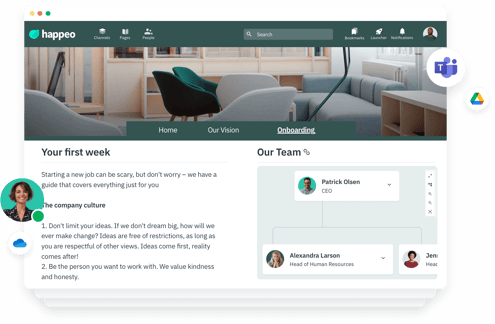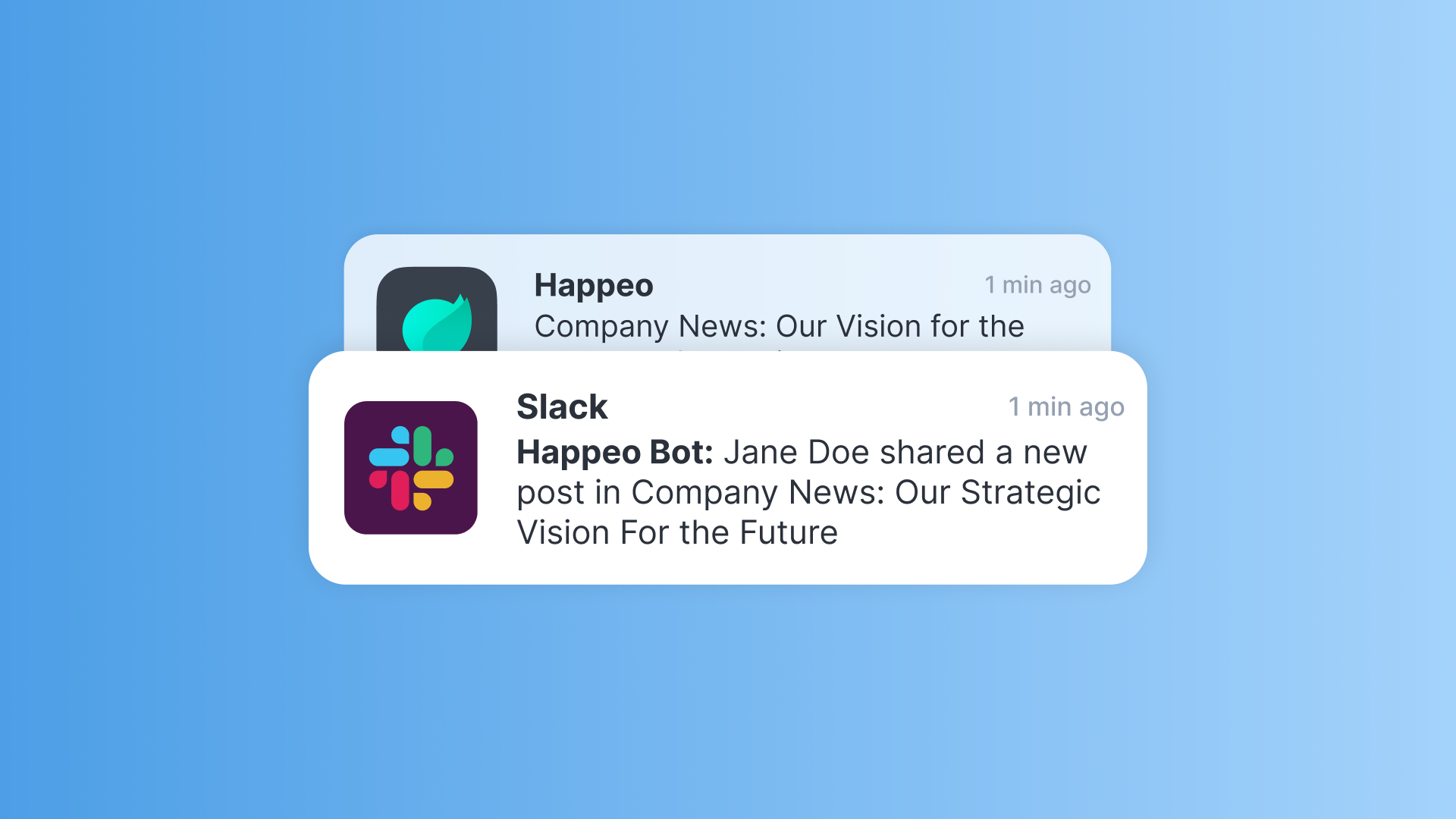
Internal Communications Expert insights
Measuring intranet ROI with cost-benefit analysis

11 mins read
Start building your digital home with Happeo
Request a demoInternal Communications Expert insights
Product
Features
Solutions
Happeo for
Use cases
Resources
Explore
Support
Happeo For
Use cases
Comparisons
Explore
Support
Recent

Jonathan Davies
11 mins read
Intranets provide businesses with tangible and intangible value.
They help streamline internal communication, act as a central hub for your organization's knowledge base, and reduce the chaos inherent in managing communication and documents across multiple apps and platforms. But, according to data from Slack, only 6% of companies actually measure their intranet ROI.
While measuring the impact and ROI of an intranet is not an exact science, there are concrete metrics you can monitor to help you better understand the value of implementing an intranet. This, in turn, can help your IT team make the case for increased investment in your intranet, whether that means more resources devoted to its upkeep or expanding its features.
We wanted to better understand why our own customers had adopted an intranet solution and which use cases generated the biggest ROI. So, at the end of 2021, we surveyed over 235 Happeo customers for our ROI Survey Report.
For this survey, 46% of respondents were in IT with the remainder represented by internal communications, marketing, HR, operations, and various leadership roles.
The respondents consisted of Happeo customers in the US, UK, Scandinavia, and Western Europe, all of whom acted as administrators of their own Happeo platform.
The top five use cases represented by the biggest ROI were:
Improved central communications: 96% of respondents said that Happeo enriched the internal content experience, with 53% saying it had improved internal communication speed.
Centralization and knowledge management: 34% of customers used Happeo to build a central source of truth to house company and departmental knowledge. These companies focus on breaking information silos and retaining knowledge by creating an information archive with a clear, searchable hierarchy.
Unified tooling and digital workspace: 11% of respondents used Happeo to replace multiple communication tools. The intranet became a one-stop shop for essential business apps. It also allowed them to access information more quickly — using Universal Search — while increasing the adoption of existing tools.
Connection and belonging: 95% of respondents said that Happeo fostered a sense of belonging by helping employees feel connected to their company and peers. By enabling two-way communication between management and employees, Happeo helped build a culture of collaboration that enabled managers to more fully recognize employee efforts and contributions.
Data-driven communication: About 7% of respondents primarily used data from Happeo to improve their Internal Comms and employee engagement. Analytics and insights helped teams optimize communication, retain employees, and foster engagement and content consumption.
Get an intranet

Measuring the ROI of an ad campaign is relatively easy (dollars in and dollars out). However, a critical business system like an intranet is a lot more nuanced, because there are more variables and intangibles at play.
When assessing your intranet ROI, start with the basic ROI formula. To do this, divide net profit by total investment and multiply by 100. It looks like this:
ROI = [net profit / total investment] x 100
The cost of your intranet software is easy to calculate, but the benefits can be difficult to quantify. To do a cost-benefit analysis, you’ll need to establish benchmarks around the tangible benefits realized from an intranet (e.g., cost savings from increased productivity). Here are some steps to get started:
Benchmark data helps you identify productivity issues and establish baseline metrics before your new intranet is in place. You'll need to get your employees involved in this process. Here's a list of metrics to evaluate by category:
Tie each benchmark to the average time it takes to accomplish, which is how you come up with a monetary value. For example, let’s say your employees spend about 2.6 hours per day (13 hours per week) sending and checking email. An intranet and knowledge base can reduce this time by eliminating the need to hunt through email and respond to individual inquiries. If the intranet saves each employee 6 hours per week, that’s a total of 24 hours per month. For an employee making the equivalent of $25/hour, that amounts to $600 per month (per employee!).
Once you have your benchmark data in place, you can revisit it about 3-6 months after the intranet is up and running. This helps you understand where (and how) employees save time, which can be directly tied back to ROI.
Measuring hard costs is one of the most straightforward ways you can assess your intranet ROI. This includes things like your cost savings on paper and printing because you’re now storing documents in the cloud.
You should also measure any ancillary costs such as employee training or setting up the intranet itself. Include subscription fees, consultant fees, and administration costs when calculating totals. These investments — either one-time or ongoing — are important to factor in when understanding your company's overall ROI.
As part of your intranet ROI formula, we recommend assigning values to productivity gains. Some values to measure include:
Once you establish how much time is being lost on various tasks and processes, you can begin to focus on automating or eliminating them.
When measuring productivity, track as many metrics as possible so you have a holistic understanding of where your employees are spending time and how the intranet can help them be more productive.
Maintaining the infrastructure to run an intranet costs money, particularly if you're using on-premises servers. If you move to the cloud, you can take advantage of economies of scale and pay only for the resources you need. Some internal costs connected to on-premises servers include:
Cloud-based intranet providers typically handle security, updates, upgrades, and support.
Retaining employees is much more cost-effective than replacing them (it can cost 1-2 times an employee's salary to replace them when they leave). An intranet helps retain employees by making it easier for them to find, share, and use the information and resources they need. This helps reduce burnout and improve the employee experience.
In a recent MetLife study, 2 in 5 employees said that knowledge-sharing has become more difficult since the pandemic, and about half said they work outside of normal working hours. Retaining employees requires giving them the tools they need to effectively manage their time and facilitate communication.
To calculate how an intranet improves retention rates, you can:
Intranets can speed up employee onboarding time by helping new hires find the materials they need quickly. It also enables them to connect with mentors and key team members and engage more fully with the company culture.
A well-designed intranet makes it easier for employees to find the resources they need when they need them. This can help reduce frustration and improve retention rates.
When assessing how an intranet reduces onboarding costs, look at:
Compare these metrics with and without the intranet to measure how the intranet reduces onboarding costs.
Here are three case study summaries that demonstrate how intranets can have a positive ROI on businesses of all sizes and types:
Doctolib, a fast-growing healthcare startup in Europe, used Happeo to integrate with Google Workspace and created a single, searchable source of truth for all their documents and information. They also integrated Slack and social channels which improved employee engagement and continue to allow themselves to scale their internal communication as their teams grow.
“We need Happeo because we're growing super fast. It's not linear growth. It's exponential growth in terms of people and ideas, so we need a place to contain our ever-increasing knowledge.”
State Auto, a century-old US insurance company, needed a flexible intranet to help streamline and facilitate internal communication. Happeo helped them pivot to an entirely remote workforce, improve productivity by reducing email volume, and enable quick access to information and colleagues via a mobile app. Team members were better able to connect with each other — and with the information they needed to do their jobs.
State Auto also benefited from Happeo's Advanced Analytics, which revealed what employees searched for and gave senior leaders visibility into how team members interact with the system.
ActivTrak, a cloud-based workforce analytics platform, wanted to move away from Slack, centralize its knowledge base, and foster culture and engagement for its remote workforce. They also needed to streamline their onboarding process, particularly since their workforce is growing rapidly.
ActivTrak used Happeo to consolidate all their information into one searchable repository and connected it with their HR system. This enabled them to automate HR tasks, like updating the perpetually changing company org chart. They also created team hubs customized to individual departments.
It's important to select a system that is highly customizable. Getting the most value from your intranet — and the highest ROI — means being proactive about how a given platform supports and integrates with your existing technology and processes. Here are some tips:
A demo lets you experience the platform's functionality in real time. It's an opportunity to make sure it can do everything you need it to do and get a feel for the UX. It also lets you ask the sales rep specific questions about whether the tool's functionality aligns with the needs of your company.
This is a zero-risk way to fully understand and compare different solutions. Per our comprehensive list of demo call questions, you should address features, onboarding, UX, pricing, integrations, security, support, and customer reviews.
Choosing a platform that you can implement quickly is one of the best ways to increase your intranet ROI. The average intranet implementation time is 1.2 years, which means that you're not seeing a return on your investment for over a year.
Happeo can be set up in as little as 6-8 weeks, which means you’ll realize the benefits of your investment much sooner. It also means that your employees — regardless of where they're located — can start collaborating and contributing to the company knowledge base right away.
A hosted solution like Happeo's is scalable, meaning you can purchase a plan that includes only the features you absolutely need. You'll get more value by avoiding expensive add-ons and functionality you won't use.
Closely evaluate the different plans available and ask about intranet integrations. Your intranet should (easily) integrate with the tools you already use like Google Workspace, Microsoft 365, or Zoom.
Choosing the right intranet platform is critical to realizing a fast ROI. Happeo checks all the boxes when it comes to features, customization, integrations, and scalability. We work with companies of all sizes across many different industries and can help get you organized and more productive in no time. Request a quote today for your scalable Happeo intranet.
